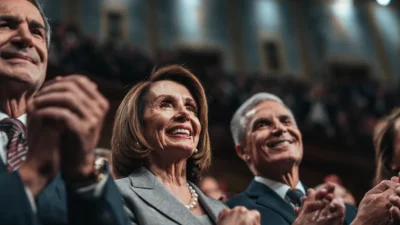TLDR
- Christopher Waller is the Governor of the Federal Reserve.
- He recently gave a speech in support of stablecoins.
- However, he noted the need for both innovation and regulation.
The Federal Reserve Governor, Christopher Waller, has called for broader access to stablecoins, advocating for both traditional banks and non-banks to issue these dollar-pegged digital currencies.
Speaking at a conference in San Francisco on February 12, Waller emphasized the role stablecoins play in modernizing payments and expanding the reach of the U.S. dollar globally. Here’s what you, as someone new to crypto, should know about what Waller said and why it matters.
What Are Stablecoins, and Why Should Anyone Care?
Let’s break it down. Stablecoins are a type of cryptocurrency that’s pegged to something stable like the U.S. dollar. Think of them as a (mostly) reliable friend in a volatile crypto world. They’re meant to avoid the wild price swings that come with currencies like Bitcoin or Ethereum.
Stablecoins can be used for things like transferring money quickly across borders, potentially replacing expensive wire transfers, or as a secure way to store value during economic instability in certain countries.
Waller described stablecoins as a critical innovation for the crypto ecosystem, with potential for crypto traders and everyday people and businesses. It’s about making money movement cheaper and faster while reducing headaches. Sounds nice, right?
However, there’s a catch — regulation. Like most things involving money, stablecoins come with risks.
Everyone’s big worry? Safety. What happens if these “stable” coins suddenly lose their peg (you’ve probably heard the term “depeg”), or what if issuers go bust? That’s where regulation comes in.
Why Waller Thinks Stablecoins Could Expand the Dollar’s Reach
You might be thinking, “Why does the Fed care about stablecoins at all?” The Fed has stated before that crypto, specifically Bitcoin, does not pose a threat to the dollar. So it makes sense for them to take a positive stance on stables as well.
Waller sees these digital dollars as a way to strengthen the position of the U.S. dollar worldwide. Imagine if people across the globe used dollar-backed stablecoins for everyday purchases. Not only would it make life easier for global consumers, but it could also reinforce the dominance of the U.S. dollar in global markets.
During his February 12th talk, Waller highlighted the maturing stablecoin market, emphasizing its ability to transform cross-border payments, retail transactions, and even provide financial support in high-inflation countries.
He noted that stablecoins could act as a bridge, giving people access to U.S. dollars even if they live somewhere with a less stable local currency.
Clever, right? Not really. That’s always been one of their biggest use cases.
However, he, just like the rest of us, knows that regulation will be what brings the rest of the world to crypto. A strong regulatory framework is needed to make stablecoins safe for users without kneecapping the innovation that makes them so promising in the first place.
A Framework for Banks and Non-Banks Alike
Not everyone agrees on who should get to issue stablecoins. Some say banks should have the monopoly since they’re already regulated up to their eyeballs.
Others argue non-banks — startups or other private-sector players like Tether — are better suited to push innovation forward.
Waller? He’s vibing with a middle ground. He said both banks and non-banks should be able to issue stablecoins, provided they follow a clear set of safety and operational rules.
What This Means For Crypto Users
Here’s what this means for a crypto beginner. If regulators adopt Waller’s vision, you might see trustworthy stablecoin projects from top banks and savvy fintech startups. That could lead to better options, stronger competition, and ultimately, a win for users like you.
Waller also acknowledged that this would require a standardized regulatory approach within the U.S. and across international borders. Right now, regulations are fragmented — kind of like when you’re trying to solve a puzzle, but every piece is from a different box.
That’s a problem if you want stablecoins to work globally, especially when you’re allowed to reach in some boxes and not in others.
The Balance Between Innovation and Safety
Balancing innovation with regulation is easier said than done. The governor thinks the private sector should be in charge of creating innovative stablecoin solutions. Meanwhile, the public sector (like, say, the Fed) should focus on crafting clear and straightforward rules so everyone knows what’s allowed and what isn’t.
Talk about a sigh of relief. It’s kind of nice hearing regulatory authorities use common sense when talking about crypto. It’s like we’re living in a brand new world.
However, there is some fragility we should mention as well. Push too hard with heavy-handed regulations, and you risk squashing the innovation that makes stablecoins exciting in the first place. Go too soft, and you’ve got a scenario ripe for scams, depegs, and consumer loss.
Waller talked about how there’s already progress in the private sector. He mentioned seeing more players building stablecoin solutions for retail payments.
Retail payments are your Starbucks coffee and your grocery store runs — not just big cross-border transactions for businesses. That will make stablecoins way more relevant to people like you in your day-to-day life.
Waller’s Hope for the Future of Stablecoins
The Governor wrapped up his speech with cautious optimism. He believes the growth of the stablecoin market should depend on how well these digital dollars actually serve consumers and the broader economy — not gimmicks or hype.
Translation? If stablecoins prove they bring real, tangible benefits to people and businesses (like lowering costs or making payments faster), they could be here for the long haul.
He ended on a forward-looking note, saying it’s up to innovators to create sustainable business opportunities around stablecoins while regulators keep everything running fairly and safely. That’s capitalism. That’s innovation. That kind of thinking got most of the Dypto Crypto team into this space.
Stablecoins, New Users, and the Bottom Line
If you’re new to crypto, Waller’s comments might make stablecoins sound like a game-changer. But the future of stablecoin use cases in the U.S., and around the world, hinges on the right balance between innovation and regulation.
For now, keep an eye on how these rules develop — they could shape how you interact with money in a digital world.
And hey, if Waller is right, the private sector might just introduce stablecoin solutions that make your Starbucks habit — and everything else in life — easier and cheaper. Lord knows those lattes aren’t getting any cheaper…












